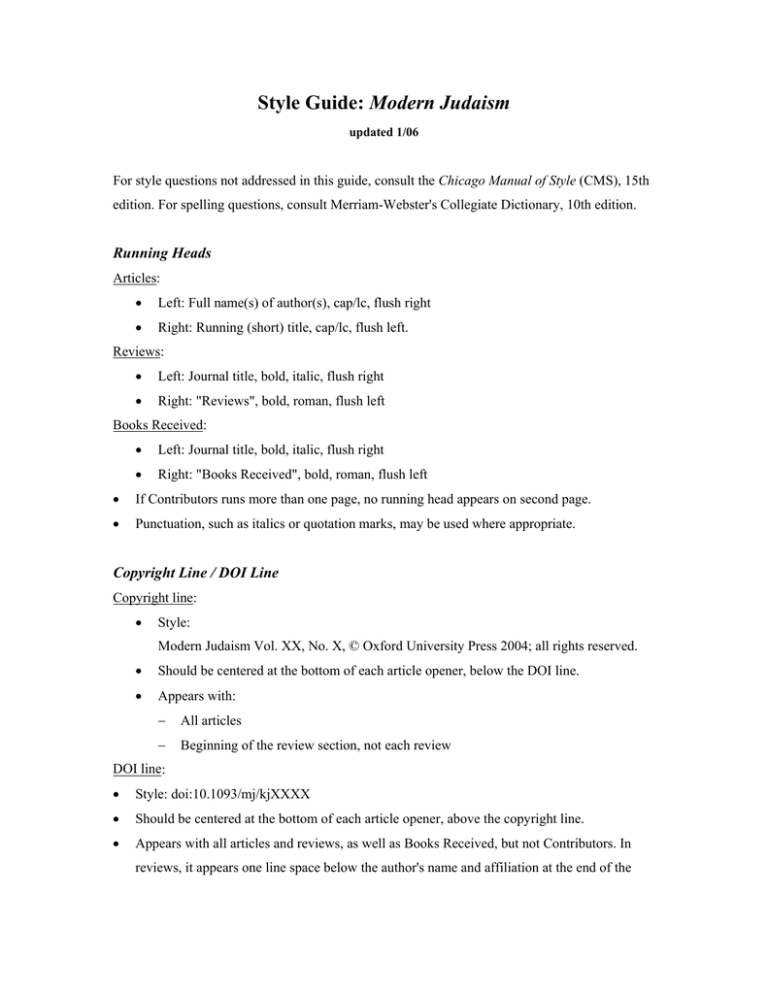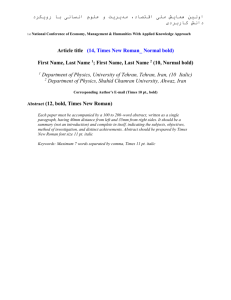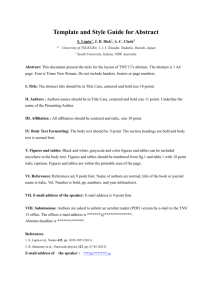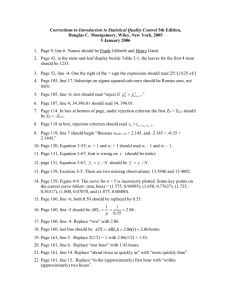
Style Guide: Modern Judaism
updated 1/06
For style questions not addressed in this guide, consult the Chicago Manual of Style (CMS), 15th
edition. For spelling questions, consult Merriam-Webster's Collegiate Dictionary, 10th edition.
Running Heads
Articles:
•
Left: Full name(s) of author(s), cap/lc, flush right
•
Right: Running (short) title, cap/lc, flush left.
Reviews:
•
Left: Journal title, bold, italic, flush right
•
Right: "Reviews", bold, roman, flush left
Books Received:
•
Left: Journal title, bold, italic, flush right
•
Right: "Books Received", bold, roman, flush left
•
If Contributors runs more than one page, no running head appears on second page.
•
Punctuation, such as italics or quotation marks, may be used where appropriate.
Copyright Line / DOI Line
Copyright line:
•
Style:
Modern Judaism Vol. XX, No. X, © Oxford University Press 2004; all rights reserved.
•
Should be centered at the bottom of each article opener, below the DOI line.
•
Appears with:
−
All articles
−
Beginning of the review section, not each review
DOI line:
•
Style: doi:10.1093/mj/kjXXXX
•
Should be centered at the bottom of each article opener, above the copyright line.
•
Appears with all articles and reviews, as well as Books Received, but not Contributors. In
reviews, it appears one line space below the author's name and affiliation at the end of the
review. In the Books Received, it appears centered at the bottom of the first page, above the
page number.
Title
Style: Centered, bold, all caps.
•
Book reviews: no title, only book citation info. First review is preceded by "Reviews"
section head (bold, cap).
Author
Style: Cap/lc, bold, italic, centered.
•
For book reviews, the reviewer's name should be given at end of piece. Name should be
in all caps.
•
For articles, author's name appears above title, separated by a graphic.
Author Affiliation
Style: All caps, roman, right aligned. Appears at end of article, before notes.
•
For book reviews, affiliation appears below reviewer's name, cap/lc, italic.
Abstract
Does not appear.
Key Words
Do not appear.
Text Format
Style:
•
H1: Centered, small caps, text below is flush left.
•
H2: Centered, cap/lc, italic, text below is flush left.
•
H3: Flush left and run into text, cap/lc, italic, followed by period.
•
For an italic heading, reverse italic should be used.
•
If all words that compose an italic heading are normally italic, they should be set in italic.
•
Extracts should be set in reduced type size.
•
British spelling is not allowed.
•
•
Preferred forms:
−
June 10, 1978 (not 10 June 1978)
−
June, 1978 (not June 1978)
−
1972–1974 (not 1972–74)
−
U.S. (not US)
−
U.K. (not UK)
−
P.O. (not PO)
−
45 percent (not 45 per cent)
−
1950s (not 1950's)
Lists: Use bulleting if appropriate, tag as <List>. Use numbering if items are referred
back to later by their numbers. (Arabic numerals preferred.)
Numbers
Style: Correct forms are as follows: 10,000; 0.01; 1,000
•
Spell out all numbers from one to one hundred, round numbers, and numbers beginning a
sentence.
•
Page numbers are usually in parentheses in text and should be preceded by p. in text and
notes (e.g., Ernest Bloch, p. 635).
Quotations/Extracts
•
Long quotations are set as extracts. A long quotation is constituted by more than 8 typed
lines or 100 words.
•
Extracts are indented on the left and right and justified.
•
Extracts are set in reduced type size, and quotation marks are omitted.
Appendices
•
Appear at end of text, before Notes.
•
Multiple appendices are designated with letters (i.e., Appendix A, Appendix B, etc.).
•
"Appendix" is set as an H1; any appendix titles are H2s.
Acknowledgments
No separate acknowledgments section—should appear at the beginning of the notes section as an
unnumbered note. Indent as with regular notes.
Endnotes
•
Endnotes are used instead of footnotes or references.
•
Appear at end of article, following the "NOTES" heading.
•
Notes section may also appear at end of book reviews.
•
Per CMS, footnote references should appear at the end of the sentence, not within a
sentence, unless there is a compelling reason for doing so. Multiple notes within the same
sentence should be combined into one note whenever possible, and author should be
queried to check the correctness of any combined notes.
•
After full reference is given once in a note, subsequent notes with the same reference may
be abbreviated to include only the author's last name, title, and page number.
•
Style:
• Book: Haim Sloves, Baruch fun Amsterdam (New York, 1956), p. 13.
• Chapter in a book: D. C. Jacobson, "The Life and Death of King Saul: Shaul
Tchernichowsky," in Modern Midrash (Albany, NY, 1987), p. 91.
• Article: Benton Johnson, Dean R. Hoge, and Donald A. Luidens, "Mainline Churches:
The Real Reason for Decline," First Things, No. 31 (1993), p. 18.
• Interview: Melkman, interview by the author, September 5, 1995.
• For other types of notes, see CMS 15.
Tables
•
Tables rarely appear. When they do, "table" and the number should appear in bold, all
caps, above the table. The title (if any) follows in bold cap/lc.
•
In text callouts, "Table" is capitalized.
•
A broadside table must appear alone on a page (no matter how short). Running heads
should not appear with broadside tables, but page numbers should.
•
A very wide table may be set across facing pages. The stub column should not be
repeated.
Figures
Rarely appear. Decisions about style can be made on a case-by-case basis.
Miscellaneous to keep in mind when copyediting:
•
When writing queries, bear in mind that authors won’t be seeing the manuscript, just page
proofs (onto which the queries will be transferred), so queries need to be understandable
when read on the proofs (i.e., “Auth: OK?” may not be clear enough). Use specific
references to the section the query concerns (e.g., Section 1, paragraph 2, sentence
beginning, "In the third chapter. . . ").
•
If no running title is provided, please create one; if necessary, query author to approve,
with “Auth: running title OK?”
•
Remember to insert the series comma if missing.
Special Terms
antisemitism (not anti-Semitism)
Gentile
halacha / halachic (not halakah, halakhic, halakic)
Sephardi (n.); Sephardic (adj.)




